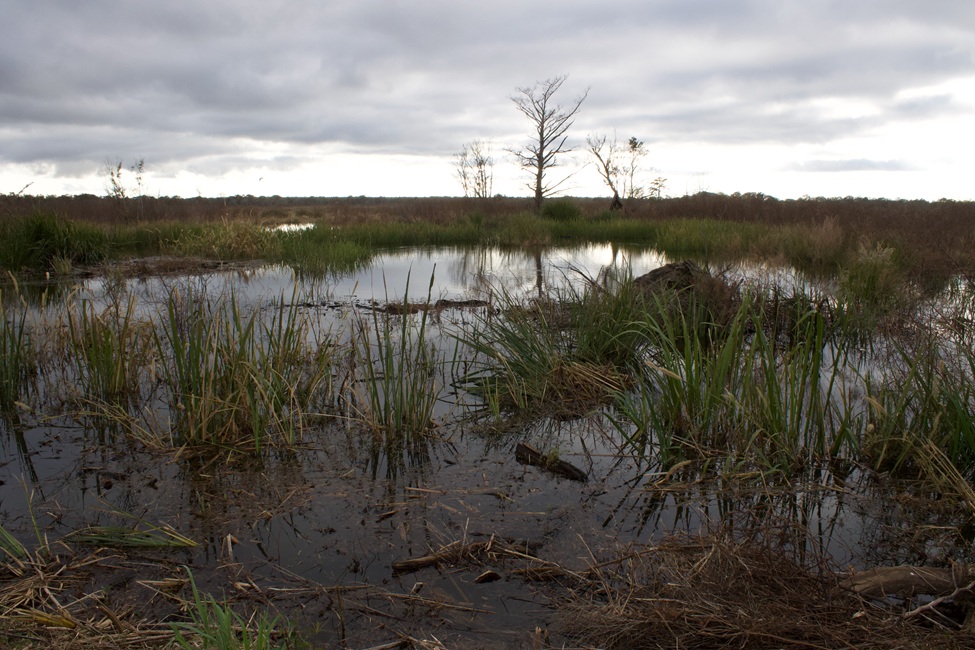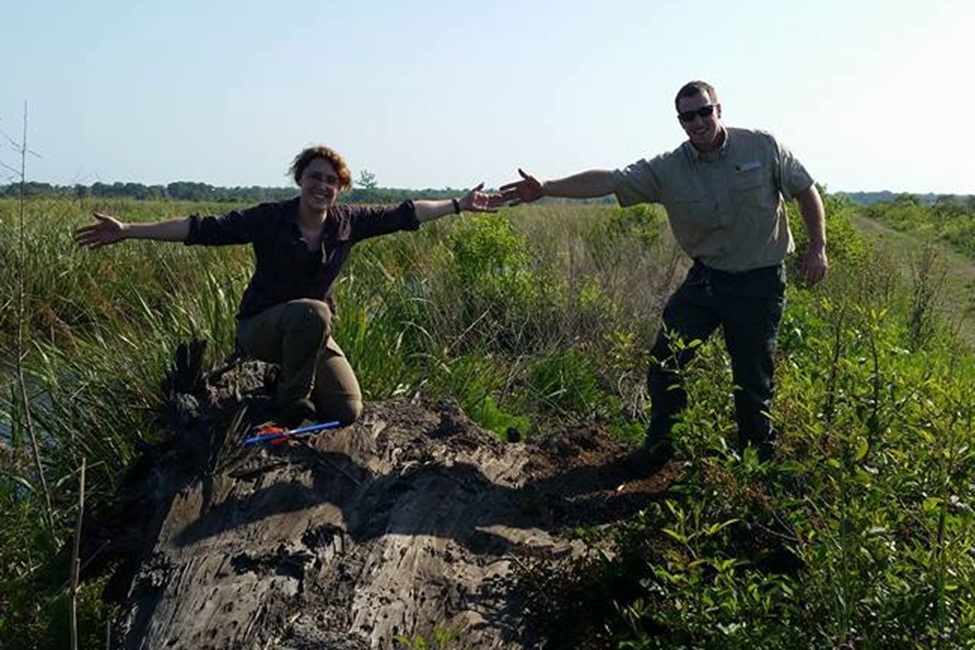Rings of Time: Unearthing Climate Secrets from Ancient Trees

Pieces of ancient stumps, roots and cypress knees hauled up during maintenance work at the Altamaha Wildlife Management Area on the Georgia Coast lie in the foreground of this flooded field.
Deep in the swamps of the American Southeast stands a quiet giant: the bald cypress (Taxodium distichum). These majestic trees, with their knobby “knees” and towering trunks, are more than just swamp dwellers – they’re some of the oldest living organisms in Eastern North America. Some have been around for more than 2,500 years, quietly thriving in nutrient-poor, flooded forests where most other trees would wither.
But life isn’t easy for these ancient trees. They’re under siege from a variety of threats: rising seas, insect infestations, wildfires and increasingly erratic weather patterns. Unlike most animals, trees generally don’t die of old age – they succumb to the stresses around them.
A study by Florida Atlantic University, in collaboration with Lynn University; the University of Georgia; the Georgia Department of Natural Resources; and the Georgia Museum of Natural History, reveals how dramatic shifts in climate can have long-lasting effects on even the toughest, most iconic trees – and offers a glimpse into the powerful forces that shape our natural world.
Researchers studied bald cypress trees from a buried deposit, preserved in subfossil form at the mouth of the Altamaha River located in Southeastern Georgia. They used radiocarbon dating, counted tree rings, and measured the width of each ring in the subfossils to investigate how these trees grew in the past. These remains tell a striking story.
Results of the study, just published in the Proceedings of the National Academy of Sciences, reveal that beginning around 500 A.D., the trees began to live shorter lives and grow at a faster pace. Before this period, bald cypress trees in the region commonly lived for more than 470 years. However, after 500 A.D., their average lifespan declined sharply to just 186 years.
This coincided with a major climate downturn in the sixth century known as the Vandal Minimum, a time of cooling temperatures and global upheaval likely caused by volcanic eruptions and possibly even a comet impact. After this period, the trees not only lived shorter lives – they also grew faster, which may have made them more vulnerable to stress and damage over time. The last of the post-500 A.D. long-lived trees died during the Little Ice Age, which lasted from about 1200 to 1850 A.D., another chilly period with big environmental changes.
Despite these troubling trends in the past, hope still stands tall in the Southeast’s old-growth swamps. In some rare pockets of preserved forest, bald cypress trees between 800 and 2,600 years old are still alive today.
Interestingly, scientists found no signs of fire, logging or human interference in the death of these trees, which makes the exact cause a mystery. However, the pattern is clear: after 500 A.D., bald cypress trees at this location on the Georgia coast never again reached their former longevity.
“This shift wasn’t a brief disruption. Even centuries later, the trees never regained their former longevity. In fact, their lifespans continued to decline over time,” said Katharine G. Napora, Ph.D., senior author and an assistant professor in the Department of Anthropology within FAU’s Dorothy F. Schmidt College of Arts and Letters . “The last of the long-lived trees found in the deposit died during another major climatic event, the Little Ice Age. Our findings underscore how long-lasting the localized effects of major climate shifts can be, especially for coastal forests that are already vulnerable to wind damage, saltwater intrusion and rising seas.”
After 500 A.D., conditions along the coast may have become more unstable, with more storms, higher salinity and less consistent flooding, making it harder for trees to survive for long periods. Pests like mites, which thrive in dry conditions, may also have contributed to increased tree death during drier periods.
For the study, researchers studied 95 ancient bald cypress trees recovered from the Altamaha Wildlife Management Area on the Georgia coast. These trees, buried for centuries, were unearthed during routine maintenance and sampled over three years. Careful testing ruled out the possibility that these results were due to differences in preservation.
“These ancient giants not only inspire awe but also serve as natural archives, helping scientists understand how trees have weathered past climate events – and how they might fare in the face of modern climate change,” said Napora.
Although the climate shift the researchers studied wasn’t truly global or perfectly synchronized across regions, the bald cypress provides a powerful lens into how widespread and enduring environmental changes can be.
“The rings of the bald cypress are like nature’s journal entries, written year by year and season by season, showing how even slow changes can shape the course of life. In their quiet persistence, these trees offer both a warning and a lesson: that the world is more interconnected than we often realize, and that the story of the Earth isn’t only told through written history – it’s etched into wood, embedded in landscapes and carried forward by living organisms,” said Napora. “The past lives on in the trunks of these ancient trees, reminding us that environmental shifts – whether natural or human-caused – reverberate through time in ways we are only beginning to understand.”
Study co-authors are Alanna L. Lecher, Ph.D., an associate professor at Lynn University; Alexander Cherkinsky, Ph.D., senior research scientist at the Center for Applied Isotope Studies at the University of Georgia; Robert Horan, a wildlife biologist; Craig Jacobs, a wildlife technician; and Blaine Tyler, a wildlife technician, all with the Georgia Department of Natural Resources; and Victor D. Thompson, Ph.D., a distinguished research professor at the University of Georgia and executive director of the Georgia Museum of Natural History.
This research was supported, in part, in association with the Georgia Coastal Ecosystems LTER project National Science Foundation (NSF) grants OCE-0620959 and OCE-123714 as well as NSF Doctoral Dissertation Improvement Award Number 1834682, the University of Georgia Department of Anthropology, and the Center for Applied Isotope Studies at the University of Georgia.

Study authors Katharine Napora, Ph.D., and Craig Jacobs, stand on the base on an ancient cypress tree hauled up from the Altamaha Wildlife Management Area on the Georgia coast.
-FAU-
Latest News Desk
- FAU Researchers 'Zoom' in for an Ultra-Magnified Peek at Shark SkinWhat gives shark skin its toughness and sleek glide? Tiny, tooth-like denticles. Researchers used electron microscopy to reveal how these structures shift with age, sex, and function in bonnethead sharks.
- FAU Receives $1.6M Gift for Student Entrepreneur ScholarshipsFlorida Atlantic University received a $1.6 million gift from long-time Boca Raton resident Bob Schattner, which will be used to continue providing scholarships that he established 15 years ago in perpetuity.
- FAU Lands $3M Federal Grant to Prevent Substance Use in At-risk Youth"Rising Strong" will support more than 3,000 South Florida youth with trauma-informed, evidence-based prevention, empowering vulnerable populations to build resilience and choose substance-free futures.
- FAU Research: Logistics Expansion Slows as Transportation Prices DropThe Logistics Managers' Index had the lowest overall reading since March as the supply chain reacts to economic uncertainty, according to researchers from Florida Atlantic University and four other schools.
- World's First Bench-to-Bedside MRI, Focused Ultrasound System UnveiledThe newly expanded FAU NeuroInnovate Center is the first in the world to integrate advanced MRI and focused ultrasound technologies into a single, unified platform for both preclinical and clinical research.
- FAU College of Business to Honor Craig ZinnFlorida Atlantic University's College of Business is hosting its 31st "Business Leader of the Year" breakfast to honor the accomplishments of Craig Zinn of Craig Zinn Automotive Group.






